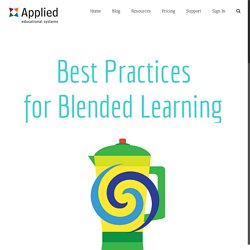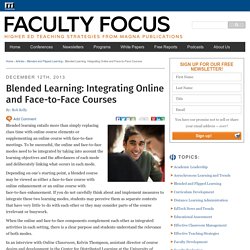

The Online Learning Teaching Techniques - eLearning Industry. Blended Learning: What Are Best Practices? By Kristin Savko What are the best practices for blended learning?

This is a bit of a loaded question. We’ve talked about it before…there isn’t really a right or wrong way to use blended learning in your classroom. Hence win-win, right? So why does it always seem so difficult? Getting the right mix I think getting the right mix is the most important part of blended learning. I’ll let Anne tell it in her own words: “And then…I met a student who didn’t speak quite so highly about our curriculum, so naturally, I wanted to know why. Day after day, she told me, the students in her class are required to sit at the computer, and review the content, and every so often, the teacher will talk about what the students have learned, and answer any questions that arise.”
How boring! Blended Learning starts with you For blended learning to be successful, the teacher has to be at the center of the learning. Nancy Welch, RN, teaches Patient Care Technician at Orlando Tech. Bottom line? Learning in Classrooms Versus Online. To the Editor: In “The Trouble With Online Education” (Op-Ed, July 20), Mark Edmundson captures the inadequacy of online courses from the teacher’s perspective, and I can corroborate from the student’s.

I was a math-obsessive in high school. To supplement my school’s curriculum, I turned to a Stanford program offering online courses to gifted youth. I started the program with enthusiasm, but I soon felt alone and unsupported. I had no one to impress or disappoint. A face-to-face meeting in a classroom imposes accountability, inspires effort and promotes academic responsibility in subtle ways that we don’t fully appreciate. Once they’re in the classroom, the battle is mostly won. ADAM D. The writer is a Rhodes Scholar and 2011 graduate of Yale Law School. To the Editor: Learning online is, of course, not the same as learning face to face, and that is likely good news for anyone who can recall an hour lost listening to an interminable lecture in an overheated classroom.
Photo. Key differences between classroom and online learning - EF Blog. The Advantages of Traditional Schools. Advantages and Disadvantages. The No Significant Difference Phenomenon by Thomas Russell cites 355 pieces of research and concludes there is no significant difference in the quality of learning between distance and face-to-face learning approaches.

Here are some possible advantages and disadvantages you might notice. Advantages Geography isn't a limiting factor. The best courses and teachers are available to you, no matter where you live. Schedules tend to be more flexible. Since many DL programs are not "time bound," busy students can study on their own time. Online Learning Vs. Classroom Learning. Online vs. Face-to-Face Learning. Face-to-Face Training Still the Better Choice Over Digital Lessons.
Blended Learning: Integrating Online and Face-to-Face Courses. December 12th, 2013 By: Rob Kelly Blended learning entails more than simply replacing class time with online course elements or supplementing an online course with face-to-face meetings.

To be successful, the online and face-to-face modes need to be integrated by taking into account the learning objectives and the affordances of each mode and deliberately linking what occurs in each mode. Depending on one’s starting point, a blended course may be viewed as either a face-to-face course with online enhancement or an online course with face-to-face enhancement. If you do not carefully think about and implement measures to integrate these two learning modes, students may perceive them as separate contexts that have very little to do with each other or they may consider parts of the course irrelevant or busywork.
Start with the learning goals. Edtrends Pros Cons ClassFormats. Online Learning. Strengths and Weaknesses of Online Learning Strengths.

There are many strengths of online learning, which is why it is becoming so popular. The most obvious are that it allows people to take classes regardless of where they live or what their schedules may be (often called "anytime, anyplace"). The asynchronous nature of the class allows students time for reflection and research and to compose their messages with more thought. Unlike face-to-face classes, there is time and space for everyone to respond to the question to be discussed or the problem to be solved. Weaknesses. Online education is not for everyone.